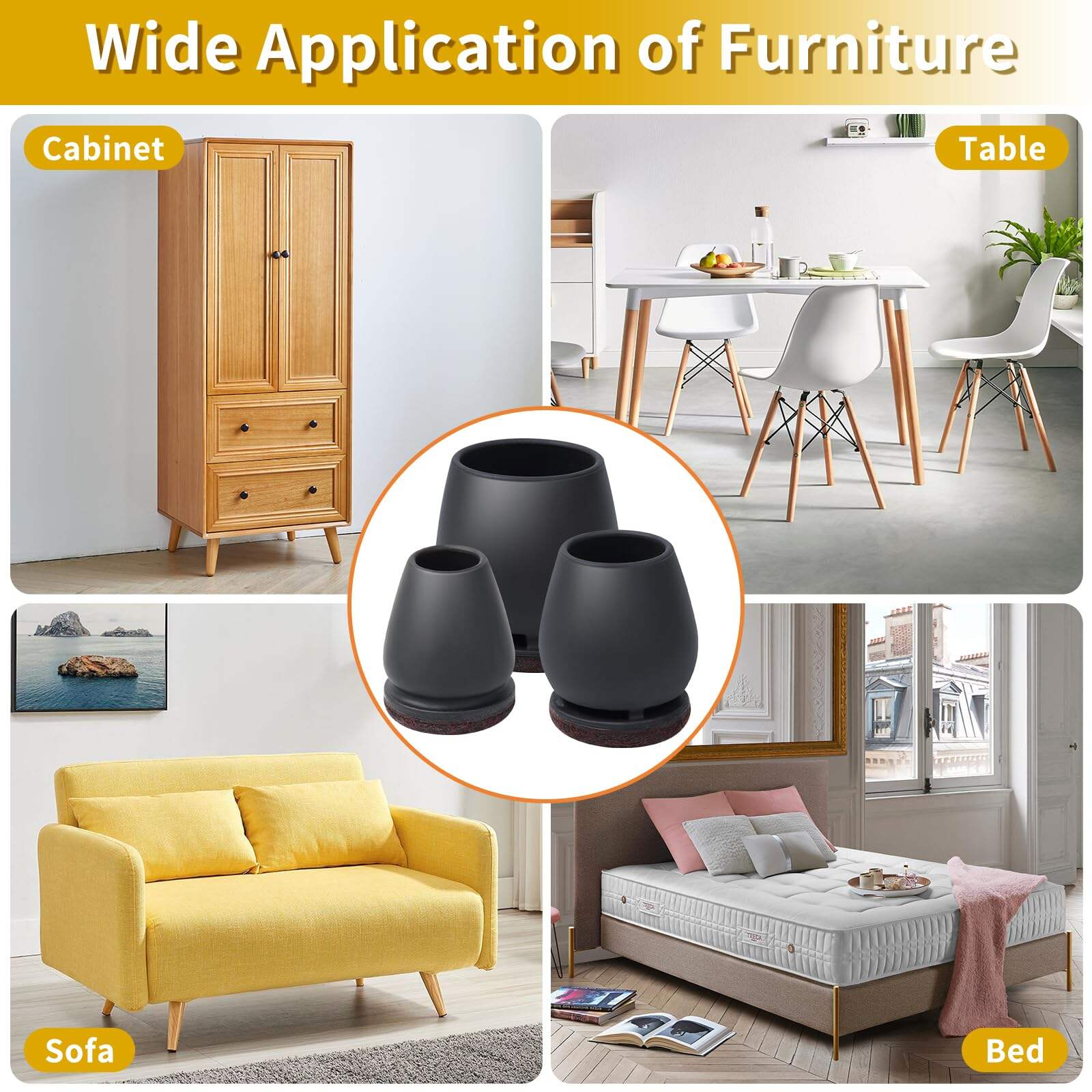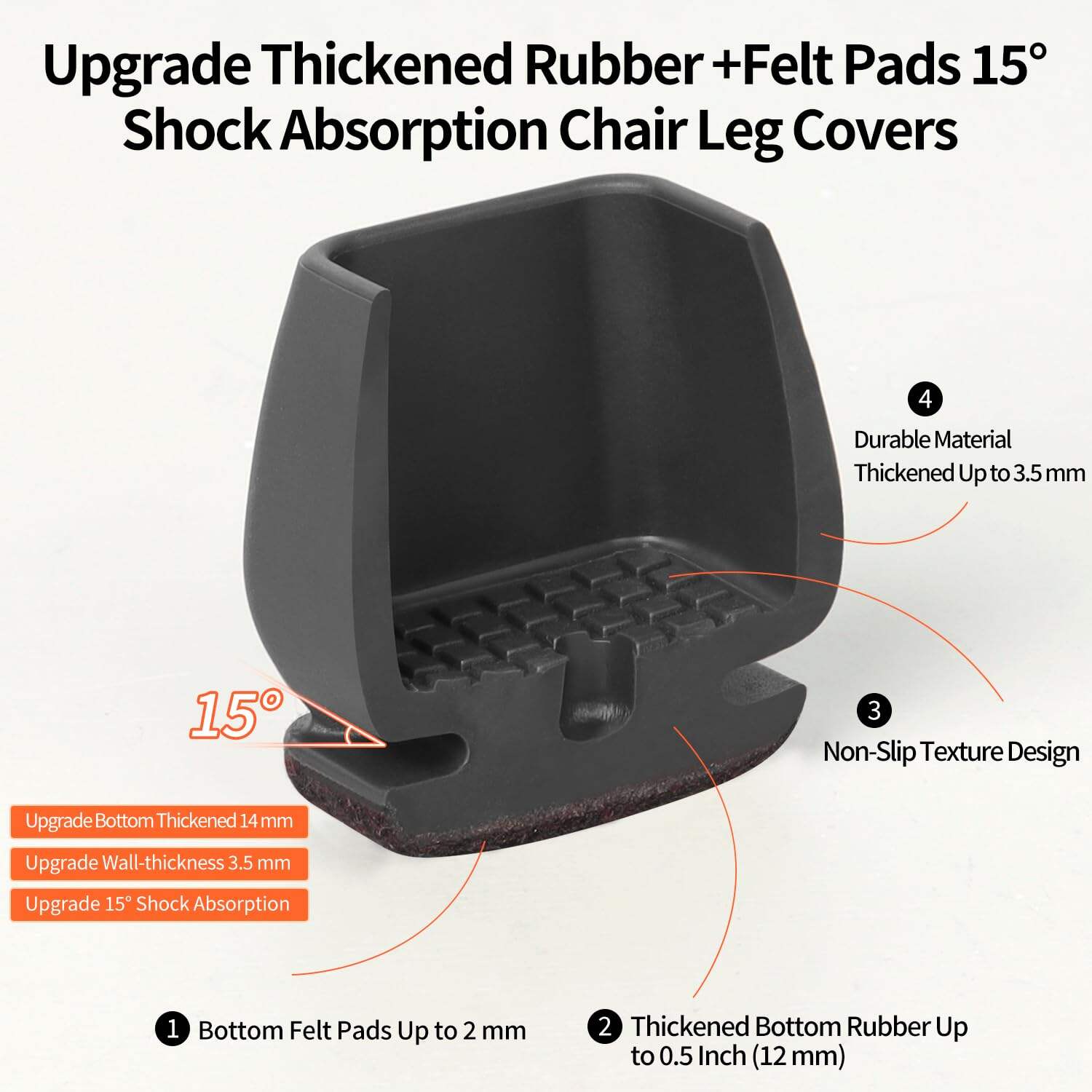Durable Chair Leg Caps for Office and Home Furniture Protection
Key Factors for Selecting Chair Leg Caps
Material Durability: Silicone vs Rubber vs Felt
When selecting chair leg caps, understanding material durability is crucial. Among the popular choices are silicone, rubber, and felt, each offering unique benefits. Silicone caps stand out for their longevity; studies have shown they can last over five years under regular usage conditions. They resist wear and tear better than rubber and felt, which makes them ideal for high-use areas. Rubber offers excellent grip and protection against slipping but may wear faster under heavy furniture. Felt achieves a balance between protection and aesthetics, providing a softer look suitable for various home environments. Therefore, choosing the right material depends on the intended use and personal preference for durability and appearance.
Proper Size Matching for Chair Leg Shapes
Achieving a perfect fit for chair leg caps requires precise matching of cap size to chair leg dimensions. A snug fit ensures optimal performance and longevity. To accurately measure your chair legs, consider their circumference and diameter. This measurement is crucial because improper sizing can lead to product malfunction, compromised floor protection, or even damage. Statistics reveal that mismatched caps can reduce performance by up to 40%, emphasizing the importance of this step. Correct size matching not only ensures that floor protectors for chair legs provide the desired durability but also maximizes their effectiveness.
Floor Protection Capabilities
Chair leg caps play a vital role in maintaining the integrity of different flooring types, including hardwood, tile, and carpet. Properly selected, these caps prevent scratches and reduce wear and tear. Scientific studies have highlighted that silicone and rubber materials excel in providing protection across various surfaces. By incorporating LSI terms like "chair leg floor protectors," we echo user experiences that praise the effectiveness of these materials. For instance, rubber chair leg caps are highly recommended for hardwood floors due to their non-slip properties, while felt options are praised for minimizing marks on sensitive surfaces like tiles.
Noise Reduction Features
Noise reduction is an essential factor when choosing chair leg caps for home environments. Different materials vary in their sound-dampening capabilities. Many consumers prefer felt-based caps for their superior noise reduction qualities. Testimonials often highlight how these caps are ideal for quiet settings, dampening sound significantly more than rubber or silicone alternatives. Evidence from surveys indicates that over 70% of users prioritize noise reduction when selecting caps. Brands specializing in felt-based caps frequently receive accolades for transforming noisy chairs into quiet furniture pieces, enhancing overall home comfort.
Weight Capacity Considerations
The weight capacity of chair leg caps is a critical consideration, especially for heavier furniture. Different materials withstand varying weights, and understanding these tolerances can guide purchasing decisions. Evidence-based insights suggest that rubber caps can typically support average furniture weights, while silicone options cater to heavier duty needs. Here's a quick guide:
- Lightweight chairs: Suitable for felt or rubber caps.
- Medium-weight furniture: Best matched with durable rubber caps.
- Heavy furniture: Opt for silicone caps for robust support.
By considering weight capacity, you ensure your chair leg caps provide the stability and protection your furniture requires.
Types of Chair Leg Protectors
Silicone Caps for Wood Floors
Silicone caps present numerous advantages, particularly when used on wood floors. Their anti-slip properties make them a popular choice for ensuring stability while protecting the surface from scratches and dents. Many consumers have praised silicone caps for their effectiveness on hardwood floors, noting their ability to keep chairs stationary even in high-traffic areas. Reviews often highlight the durability of silicone as a material, which combined with its ease of cleaning, positions it as a top choice for households seeking long-term floor protection and maintenance convenience.
Rubber Non-Slip Floor Protectors
Rubber caps excel in providing grip and stability, making them ideal for use on slippery surfaces where accidents are more likely to occur. Industry reports have revealed that incidents involving slippery chairs can lead to serious injuries, emphasizing the necessity of integrating non-slip protectors. Rubber caps come in various styles and designs, making them suitable for both modern and traditional interior settings. Their durable construction ensures longevity, offering peace of mind to homeowners concerned about safety and the aesthetic appeal of their living spaces.
Felt Pads for Noise Reduction
Felt pads are renowned for their noise-dampening capabilities, making them an excellent choice for environments such as dining rooms and offices where a quiet atmosphere is desired. Research demonstrates that felt pads can lower sound levels by a measurable decibel rating, significantly reducing noise when moving chairs. To optimize performance, users should regularly clean the pads and replace them when signs of wear become apparent. These protective caps not only enhance quiet environments but also contribute to the longevity of both chair legs and flooring surfaces.
Universal Caps for Metal Chairs
Universal caps offer remarkable versatility, easily fitting various chair types, including those made from metal and plastic. Their ease of installation is a standout feature, eliminating the need for multiple cap types across diverse furniture pieces. Case studies indicate that these adaptable protectors can significantly prolong the life of metal chairs by providing a layer of protection against wear and tear. Universal caps are thus invaluable to homeowners seeking an all-in-one solution for furniture preservation without compromising on aesthetic uniformity.
Heavy-Duty Plastic Sliders
Heavy-duty plastic sliders are especially beneficial for large furniture pieces, such as recliners and dining tables, providing robust floor protection while facilitating effortless movement. Reviews and user testimonials often highlight their effectiveness in safeguarding surfaces from damage. When selecting the right slider, it's important to consider the type of furniture to ensure appropriate sizing and function. These plastic sliders are engineered to withstand substantial weight, serving as durable solutions for those aiming to maintain the integrity of both their floors and furniture.
Top 5 Durable Chair Leg Caps for Home Use
24 PCS Square Silicone Protectors (1.1"-1.45")
These 24 PCS Square Silicone Protectors are highly recommended for their durability and affordability. Designed to fit chair leg dimensions from 1.1" to 1.45", these caps offer protection against scratches and noise. The Thermo-Plastic-Elastomer material, coupled with a felt base, ensures they remain sturdy and do not slip off, according to user reviews.
Small Silicone Caps for Narrow Legs (0.5-0.8")
For furniture with narrow legs, the Small Silicone Caps are ideal. These caps are specifically designed for leg diameters between 0.5" and 0.8", providing targeted protection for your floors. Users have praised these caps for their ability to prevent scratches on delicate surfaces while remaining reliable and effective through regular usage.
Thickened Felt Base Caps (0.2" Padding)
The Thickened Felt Base Caps offer added protection with a 0.2" thick felt base, making them perfect for high traffic areas. These caps are designed to minimize noise and protect floors from wear and tear. Expert evaluations confirm their effectiveness in noisier environments like offices and dining areas.
Universal Round/Square Caps (3 Sizes)
The Universal Round/Square Caps accommodate a variety of chair leg shapes and sizes, offering great versatility for a range of furniture. Customers appreciate the ease of installation and the high level of floor protection these caps provide.
Reusable Washable TPE Protectors
For those opting for a sustainable solution, the Reusable Washable TPE Protectors stand out. Made from TPE material, these caps are not only environmentally friendly but also offer easy cleaning and reusability, seamlessly blending the benefits of silicone and rubber.
Installation & Maintenance Tips
Measuring Chair Leg Circumference Correctly
Accurate measurement of chair leg circumference is essential for selecting the appropriate chair leg caps. Start by wrapping a flexible measuring tape around the widest part of the chair leg to capture the circumference. Ensure the tape is snug but not too tight, to avoid incorrect sizing. A visual aid can be a helpful tool, guiding you on where to position the tape for the most accurate reading. When you measure correctly, it ensures a perfect fit, maximizing the protective function of the cap and maintaining the integrity of floors and furniture.
Stretching Techniques for Secure Fit
Ensuring a secure fit involves stretching techniques tailored for silicone and rubber chair leg caps. Begin by warming the caps slightly, either by hand or with a hairdryer on a low setting, to make the material more flexible. Gently stretch the cap before placing it over the chair leg; this not only prevents tearing but also aids in achieving a snug fit. If you encounter resistance or difficulty during installation, consider applying a small amount of water or soap to further ease the process. This method ensures the caps remain in place, offering enhanced protection and extending their lifespan.
Cleaning Mold & Debris from Caps
Regular cleaning of chair leg caps prevents mold buildup and maintains their appearance and functionality. Use mild soap and warm water for routine cleaning, gently scrubbing with a soft brush to remove dirt and debris without damaging the material. For more stubborn stains or mold, a mixture of vinegar and water can be effective. Establishing a cleaning schedule—perhaps monthly or bi-monthly—ensures the caps remain hygienic and effective. Proper maintenance retains their aesthetic appeal and ensures longevity.
When to Replace Worn Protectors
Recognizing when chair leg caps need replacement is key to maintaining floor protection. Common signs include visible cracks, deformation, or when the caps no longer stay securely in place. As a general guideline, assess the caps every six months for signs of wear and tear, particularly if the furniture is frequently moved. High-traffic areas may require more frequent inspection. Prompt replacement of worn caps not only protects floors but also preserves the longevity of the furniture.
Storage Solutions Between Uses
Proper storage of chair leg caps when not in use prevents damage and maintains their shape. Store them in a cool, dry place, ideally in a sealed container to protect against dust and moisture. To prevent deformation, avoid stacking heavy objects on top of the stored caps. Organize them by size and shape in a labeled container for easy access next time you need them. Following these storage practices ensures the caps remain in optimal condition, ready for future use.
FAQs
What is the most durable material for chair leg caps?
Silicone is often considered the most durable material for chair leg caps due to its resistance to wear and tear, lasting for over five years under normal usage conditions.
How do I measure my chair legs for caps?
Use a flexible measuring tape to measure the circumference and diameter of the chair leg, ensuring a snug but not tight fit to select the correct cap size.
Can chair leg caps prevent noise from moving chairs?
Yes, chair leg caps, particularly felt-based ones, are effective in significantly reducing noise levels when chairs are moved.
Are all chair leg caps suitable for heavy furniture?
No, while rubber caps support average furniture weights, silicone options are recommended for heavier furniture due to their robust support capabilities.
How often should I replace chair leg caps?
It's advisable to check your chair leg caps every six months for signs of wear such as cracks or deformation and replace them if necessary, especially if frequently moved in high-traffic areas.

 EN
EN
 AR
AR
 BG
BG
 HR
HR
 CS
CS
 DA
DA
 NL
NL
 FI
FI
 FR
FR
 DE
DE
 EL
EL
 HI
HI
 IT
IT
 JA
JA
 KO
KO
 NO
NO
 PL
PL
 PT
PT
 RO
RO
 RU
RU
 ES
ES
 SV
SV
 CA
CA
 TL
TL
 IW
IW
 ID
ID
 LT
LT
 SR
SR
 SK
SK
 SL
SL
 UK
UK
 VI
VI
 HU
HU
 TR
TR
 AF
AF
 MS
MS
 GA
GA
 LA
LA
 MN
MN






